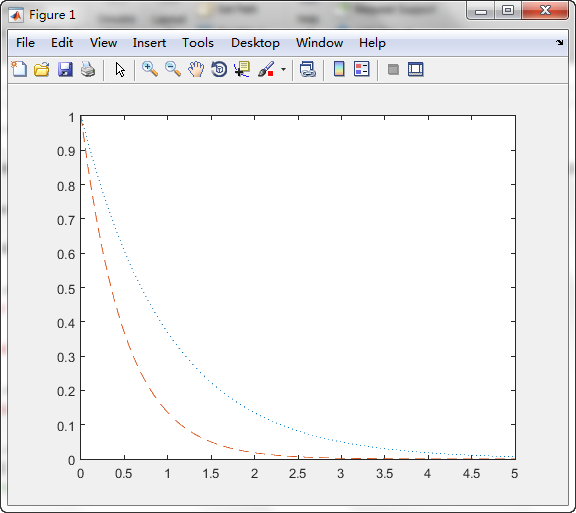绘图
单变量函数
在 MATLAB 中绘图包含下面三个步骤:
定义函数
指定要绘制的函数图形的值范围
调用 MATLAB 的 plot(x, y)函数
当指定函数的值范围时,我们必须告诉 MATLAB 函数使用的变量的增量。使用较少的增量可以使得图形显示更加平滑。如果增量较小,MATLAB 会计算更多的函数值,不过通常不需要取得那么小。我们用一个简单的例子来看看如何做。
我们绘制 0≤x≤10 之间的 y = cos(x)的图形。绘制之前,我们要定义这个区间并告诉
MATLAB 我们所使用的增量。区间使用方括号[]以下面的形式定义:[ start : interval : end ]
例如,如果我们要告诉 MATLAB 在 0≤x≤10 上以 0.1 的增量(间隔)递增,我们输入:
[0:0.1:10]
用赋值运算符给这个范围内的变量一个名称,也用这种办法告知 MATLAB 相关变量和我们要绘制的函数。因此,要绘制 y = cos(x),我们输入下面的命令:
1 | >> x = [0:0.1:4*pi]; |
注意我们每行都以分号“;”结尾,记住,这会抑制 MATLAB 输出。你不会想让 MATLAB
在屏幕中间输出一大串 x 值,因此使用了分号。现在我们可以输入下面的命令绘图了:>> plot(x, y), xlabel('x'), ylabel('cos(x)')

fplot
上面的例子只是简单的提供了一种图形曲线画法函数,然而当我们遇到需要多个包含变量的函数进行乘除运算时,就会出现:
1 | >> t = [0:0.02:4]; |
为什么会出现这种情况呢?在Matlab中,x是一个[0:0.02:4]的矩阵,同样sin(x)也是一个矩阵。*是矩阵乘法operator。x是一个长度为200的矩阵,sin(x)也是如此。也就是说,x和sin(x)都是1*200的矩阵,这在矩阵乘法中显然是无法进行的。所以提醒Inner matrix dimensions must agree
此时我们可以使用dot乘,对应元素分别相乘。
exp(-2*x).*sin(x)
或者使用fplot函数:
1 | >> help fplot |
fplot 为你产生尽可能精确的的图象,同时它也帮助我们绕过像这样的错误。调用 fplot 的形式如
fplot('function string', [xstart, xend])
参数 function string 告诉 fplot 你所要绘制的图象函数,而 xstart 和 xend 定义了函数的区间。
>> fplot('exp(-2*t)*sin(t)',[0, 4]), xlabel('t'), ylabel('f(t)'),title('阻尼弹力')
多个函数
Matlab支持多个函数在一张图表中显示:
1 | >> t = [0:0.01:5]; |
上面的例子告诉Matlab要绘制 f(t)和 g(t)函数,并且第二个函数曲线使用虚线。
实线 ‘-‘
虚线 ‘–’
虚点线 ‘-.’
点线 ‘:’
>> plot(t,f,':',t,g,'--')

添加图例
专业的图象总是附有图例,告诉读者某个曲线是什么。在下面的例子中,假设我们要绘制两个表示势能的函数,它们由双曲三角函数 sinh(x)和 cosh(x)定义,定义域为 0≤x≤2。首先我们定义x:
>> x = [0:0.01:2];
现在我们定义这两个函数,在 MATLAB 中把函数称为 y 并不是什么不可思议的事,所以我们把第二个函数称为 z,因此有:
1 | >> y = sinh(x); |
legend 命令用起来很简单。只需把它加在 plot(x,y)命令后面,并用单引号把要添加为图例的文本引起来。在这个例子中我们有:
legend('sinh(x)','cosh(x)')
我们只需把这一行添加到 plot 命令后面。在这个例子中,我们还包含 x 和 y 标签,第一条曲线用实线而第二条曲线用虚点线:
1 | >> plot(x,y,x,z,'-.'), xlabel('x'), ylabel('Potential'), legend('sinh(x)','cosh(x)') |

颜色设置
相比其他类似的开发工具,Matlab画图是也同样支持设置图像颜色。
plot(x,y,'r',x,z,'b--')
上面的代码代表第一个函数为红色,第二个以虚线填充的函数为蓝色。
白色 w
黑色 k
蓝色 b
红色 r
青色 c
绿色 g
洋红 m
蓝色 y
设置坐标比例
axis命令可以设置绘图范围。通过用下面的方式调用 axis 命令:
axis ([xmin xmax ymin ymax])
